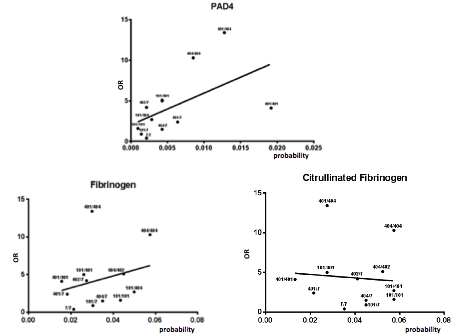Session Information
Date: Tuesday, November 7, 2017
Title: Rheumatoid Arthritis – Human Etiology and Pathogenesis Poster III
Session Type: ACR Poster Session C
Session Time: 9:00AM-11:00AM
HLA-DRB1 genotypic risk to develop ACPA positive RA correlates with capability of encoded HLA-DRB1 chains to bind Peptidyl Arginyl Deiminase (PAD4) peptides, not citrullinated Fibrinogen peptides.
Background/Purpose: The risk to develop ACPA positive RA is controlled by HLA-DRB1 genotypes. This may be due to the binding of citrullinated peptides by HLA-DRB1 chains encoded by each genotype. Alternatively, we propose that binding of peptides from PAD4 by HLA-DRB1 allows to help the production of antibodies to citrullinated epitopes on any protein bound by PAD4.
Methods: We studied the binding of 65 overlapping peptides from PAD4 and 96 overlapping peptides from the Fibrinogen alpha and beta chains under their native or citrullinated form to purified HLA-DRB1*0401, *0404, *0101, *0402, *0701 by ELISA. We calculated a likelihood of binding at least one peptide from PAD4, native Fibrinogen or citrullinated Fibrinogen by the two HLA-DRB1 chains encoded by each possible genotype and compared it with the risk carried by the same genotype to develop ACPA positive RA.
Results: HLA-DRB1 genotypic risks to develop RA correlate with likelyhood to bind PAD4 peptides (P=0.06, Pearson’s), not citrullinated Fibrinogen peptides (p >0,6 and p>0.9) (Figure 1).
Conclusion: Comparison of binding properties of HLA-DRB1 molecules in each of 12 genotypes to PAD4 or native or citrullinated Fibrinogen peptides suggests restriction of PAD4 presentation may explain the association of HLA-DRB1 alleles with ACPA positive RA
Figure 1 : OR to develop RA correlates with probability to bind at least one peptide from PAD4, not Fibrinogen or citrullinated Fibrinogen
To cite this abstract in AMA style:
Auger I, Balandraud N, Roudier J. For Each HLA-DRB1 Genotype, the Likelihood to Develop RA Correlates with the Probability of Binding at Least a Peptide from PAD4 [abstract]. Arthritis Rheumatol. 2017; 69 (suppl 10). https://acrabstracts.org/abstract/for-each-hla-drb1-genotype-the-likelihood-to-develop-ra-correlates-with-the-probability-of-binding-at-least-a-peptide-from-pad4/. Accessed .« Back to 2017 ACR/ARHP Annual Meeting
ACR Meeting Abstracts - https://acrabstracts.org/abstract/for-each-hla-drb1-genotype-the-likelihood-to-develop-ra-correlates-with-the-probability-of-binding-at-least-a-peptide-from-pad4/

